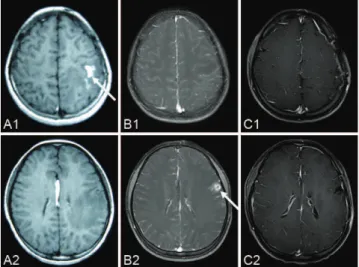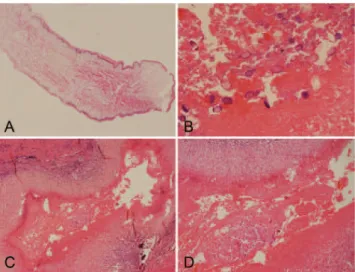CASE REPORT
The surgical removal of a live tapeworm with an
interesting pathologic finding most likely
represent-ing the migration path: a case report of cerebral
sparganosis
Peng Wang,I,IIXueying Su,III Qing Mao,IYanhui LiuI
ISichuan University, West China Hospital, Department of Neurosurgery, Chengdu, China.IIThe Fifth People’s Hospital of Chengdu, Department of
Neurosurgery, Chengdu, China.IIISichuan University, West China Hospital, Department of Pathology, Chengdu, China.
Email: liuyanhui9@gmail.com Tel.: 8618980601509
INTRODUCTION
Cerebral sparganosis is a rare parasitic disease of the central nervous system that is caused by sparganum. Cerebral sparganosis occurs worldwide, but it is found more frequently in China, Japan, and Southeastern Asia (1-2). Sparganum, the second-stage larva ofSpirometra mansoni, can produce chronic active inflammation through slow migration in the brain (1). They can also parasitize other sites of the human body, such as the subcutaneous tissue, body cavities and eyes, and survive for 5-20 years (3).
In this paper, we report a case of cerebral sparganosis, including the magnetic resonance imaging (MRI) character-istics of local migration and the surgical finding of a live worm. A new pathological finding, a tunnel-like structure, was observed and most likely represented a sparganum migration path.
CASE DESCRIPTION
A fifteen-year-old girl suffered from facial and upper limb numbness on her right side one year ago. She was previously diagnosed with encephalitis at the Department of Neurology until she suffered a generalized tonic–clonic seizure six months later. MRI showed a contrast-enhanced lesion with an irregular shape located in the left frontal lobe (Figure 1 A1 and A2). The patient was advised to undergo further treatment in the Department of Neurosurgery. However, because the seizure was acutely controlled, she was noncompliant with treatment. One week before admis-sion, the seizure became uncontrollable. An MRI revealed a contrast-enhanced lesion with an irregular shape (Figure 1 B1 and B2); however, local migration of the lesion was observed.
After admission, the patient’s serum was tested by ELISA, which was positive for sparganum. The patient mentioned that she had eaten inadequately cooked frog flesh.
Therefore, we hypothesized that the lesion was a live tapeworm. An operation was performed, and a light yellow lesion was identified in the posterior portion of the superior temporal gyrus with a live worm inside it. The worm was milky white, approximately 12cm long and could twist its body under stimulus (Figure 2).
The histology of the larval cestode showed a brush border and eosinophilic smooth muscle fibers (Figure 3A). Some portions of the parasite body contained calcareous bodies (Figure 3B). A new tunnel-like structure with infiltrating plasma cells and eosinophils was identified in the tissue (Figure 3C). Under higher power, calcareous bodies were also observed within the tunnel (Figure 3D). Based on the pathological findings, the patient history and serum test results, a final diagnosis of cerebral sparganosis was made. During a follow-up period of more than two years, the patient’s symptoms disappeared. No enhanced lesion was found on MRI at 26 months after the operation (Figure 1 C1 and C2).
Copyrightß2012CLINICS– This is an Open Access article distributed under
the terms of the Creative Commons Attribution Non-Commercial License (http:// creativecommons.org/licenses/by-nc/3.0/) which permits unrestricted non-commercial use, distribution, and reproduction in any medium, provided the original work is properly cited.
No potential conflict of interest was reported.
Figure 1 -A series of pre-operational MR images demonstrates the local migration of an irregular, enhanced lesion (arrow) in the left hemisphere (A1-A2) six months before the operation; (B1-B2) three days before the operation. The lesion disappears in the post-operation MR images over the two-year follow-up period (C1-C2) 26 months after the operation.
CLINICS 2012;67(7):849-851 DOI:10.6061/clinics/2012(07)24
DISCUSSION
The clinical manifestations of cerebral sparganosis include seizure, hemiparesis, and headache with a chronic course, in which seizure is the most common symptom (1,4). In our case, the patient first presented with sensation disorders on her right side and later with seizure. Serum ELISA is sensitive against sparganum and was essential evidence in our patient’s diagnosis.
The characteristics of cerebral sparganosis on MRI include the following: A) degeneration of the cerebral white matter with edema and ventricle dilation; B) a contrast-enhanced lesion with an irregular shape, a string-of-beads shape or tunneling signs; and C) local or contralateral migration of the lesion or a change of the shape in follow-up MRI studies (1-2,5-6). Migration may suggest a live tapeworm (1,7-8), which was observed and confirmed in this case. Other infectious granulomas, primary or secondary neoplasms, chronic infarctions, and degenerative diseases should be excluded from the diagnosis (4). Rengarajan et al. (9) indicated that cerebral sparganosis mimicked a tuberculoma on imaging, which should be included in the differential diagnosis. The patient in this case was previously diagnosed with encephalitis, which should also be included in the differential diagnosis.
The main pathologic findings in cerebral sparganosis include larval cestodes with a brush border and eosinophilic smooth muscle fibers and granulomas with calcareous bodies surrounded by plasma cells and eosinophils (1,6-8,10). In our case, a new tunnel-like structure with infiltrating plasma cells and eosinophils was found in addition to the previously mentioned structures. Calcareous bodies were also observed within the tunnel under higher power. This tunnel-like structure was most likely the migration path of the spar-ganum, suggesting that migration phenomena may be significant histological evidence.
Neurocysticercosis is the most common parasitic disease of the human central nervous system, and it should be considered as a very important differential diagnosis in cases such as the present one. Similar to cerebral sparga-nosis, neurocysticercosis typically develops following oral ingestion of the parasite, and seizures and headache are the most commonly encountered symptoms (11). However, several factors can differentiate between the two infections: A) there are some highly suggestive radiological findings for neurocysticercosis, such as cyst structures (containing a scolex), enhancing lesions, and parenchymal calcifications (12); B) the detection of Taenia solium antigens or anti-T. solium antibodies in serum or cerebrospinal fluid can suggest the presence of neurocysticercosis (13); and C) cysticerci in different stages that are associated with inflammatory responses can be found upon microscopic examination.
Surgical resection of the lesion, including the tapeworm and the granuloma, is considered to be an effective treatment for cerebral sparganosis. Patients with total lesion excision can achieve good long-term outcomes (1). Many researchers (1-2,7-8) recommend surgery for patients with a live worm and signs of migration on MR images because this can prevent further damage caused by disease progression. Drug therapy, such as praziquantel, has a limited effect because live tapeworms are not affected (1). In this case, the operation was performed because local migration that was suggestive of a live worm was observed on serial MR images. The patient’s symptoms disappeared, and recurrence was not observed over a follow-up period of more than two years.
In conclusion, the observed migration was an important radiological sign for preoperative diagnosis, identification of tapeworm survival, and judgment of surgical indication. The tunnel-like structure demonstrated by pathology might be an important diagnostic clue for cerebral sparganosis.
AUTHOR CONTRIBUTIONS
Wang P drafted the manuscript, reviewed the literature, and participated in the operation. Su XY made the histopathologic diagnosis. Mao Q and Liu YH performed the operation and revised the manuscript.
REFERENCES
1. Kim DG, Paek SH, Chang KH, Wang KC, Jung HW, Kim HJ, et al. Cerebral sparganosis: clinical manifestations, treatment, and outcome. J Neurosurg. 1996;85(6):1066-71.
2. Moon WK, Chang KH, Cho SY, Han MH, Cha SH, Chi JG, et al. Cerebral sparganosis: MR imaging versus CT features. Radiology. 1993;188(3):751-7.
3. Cho SY, Bae JH, Seo BS. Some Aspects Of Human Sparganosis In Korea. Kisaengchunghak Chapchi. 1975;13(1):60-77.
4. Chang KH, Chi JG, Cho SY, Han MH, Han DH, Han MC. Cerebral sparganosis: analysis of 34 cases with emphasis on CT features. Neuroradiology. 1992;34(1):1-8, http://dx.doi.org/10.1007/BF00588423. 5. Song T, Wang WS, Zhou BR, Mai WW, Li ZZ, Guo HC, et al. CT and MR characteristics of cerebral sparganosis. AJNR Am J Neuroradiol. 2007;28(9):1700-5, http://dx.doi.org/10.3174/ajnr.A0659.
6. Kim IY, Jung S, Jung TY, Kang SS, Chung TW. Contralateral migration of cerebral sparganosis through the splenium. Clin Neurol Neurosurg. 2007;109(8):720-4, http://dx.doi.org/10.1016/j.clineuro.2007.05.014. Figure 2 - A live tapeworm with the scolex, measuring
approximately 12 cm in length, extracted from the patient (arrow).
Figure 3 -Histological findings of the larval cestode and lesion. (A) Photomicrograph of the live larval showing a brush border and eosinophilic smooth muscle fibers (H&E 4X). (B) Photomicrograph showing calcareous bodies (H&E 40X). (C) A tunnel-like structure surrounded by plasma cells and eosinophils. (H&E 10X). (D) Calcareous bodies were observed within the tunnel. (H&E 20X). An interesting pathologic finding in cerebral sparganosis
Wang P et al. CLINICS 2012;67(7):849-851
7. Murata K, Abe T, Gohda M, Inoue R, Ishii K, Wakabayashi Y, et al. Difficulty in diagnosing a case with apparent sequel cerebral sparganosis. Surg Neurol. 2007;67(4):409-11, http://dx.doi.org/10.1016/j.surneu.2006.06.056. 8. Bo G, Xuejian W. Neuroimaging and pathological findings in a child with cerebral sparganosis. Case report. J Neurosurg. 2006;105(6 Suppl):470-2. 9. Rengarajan S, Nanjegowda N, Bhat D, Mahadevan A, Sampath S,
Krishna S. Cerebral sparganosis: a diagnostic challenge. Br J Neurosurg. 2008;22(6):784-6, http://dx.doi.org/10.1080/02688690802088073. 10. Cummings TJ, Madden JF, Gray L, Friedman AH, McLendon RE. Parasitic
lesion of the insula suggesting cerebral sparganosis: case report. Neurora-diology. 2000;42(3):206-8, http://dx.doi.org/10.1007/s002340050047.
11. Carabin H, Ndimubanzi PC, Budke CM, Nguyen H, Qian Y, Cowan LD, et al. Clinical manifestations associated with neurocysticercosis: a systematic review. PLoS Negl Trop Dis. 2011;5(5):e1152, http:// dx.doi.org/10.1371/journal.pntd.0001152.
12. Moskowitz J, Mendelsohn G. Neurocysticercosis. Arch Pathol Lab Med. 2010;134(10):1560-3.
13. Rodriguez S, Dorny P, Tsang VC, Pretell EJ, Brandt J, Lescano AG, et al. Detection of Taenia solium antigens and anti-T. solium antibodies in paired serum and cerebrospinal fluid samples from patients with intraparenchymal or extraparenchymal neurocysticercosis. J Infect Dis. 2009;199(9):1345-52.
CLINICS 2012;67(7):849-851 An interesting pathologic finding in cerebral sparganosis Wang P et al.

